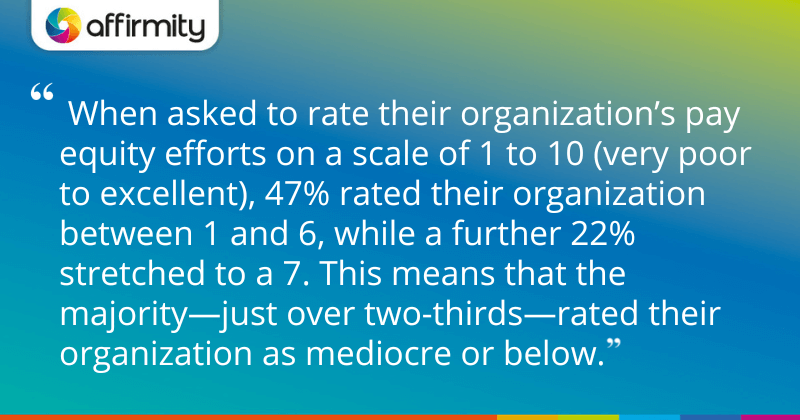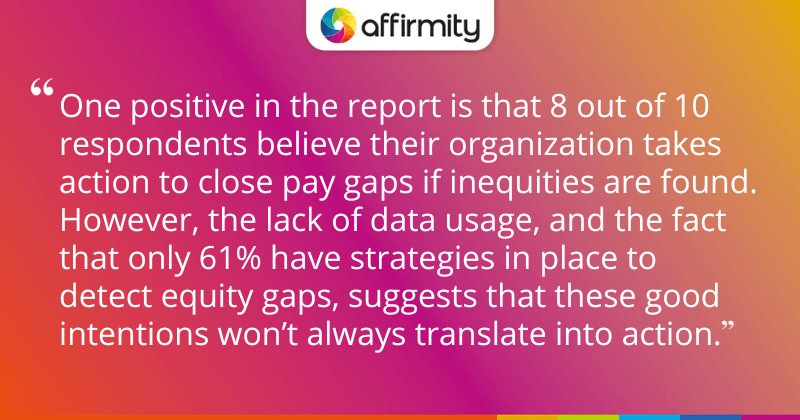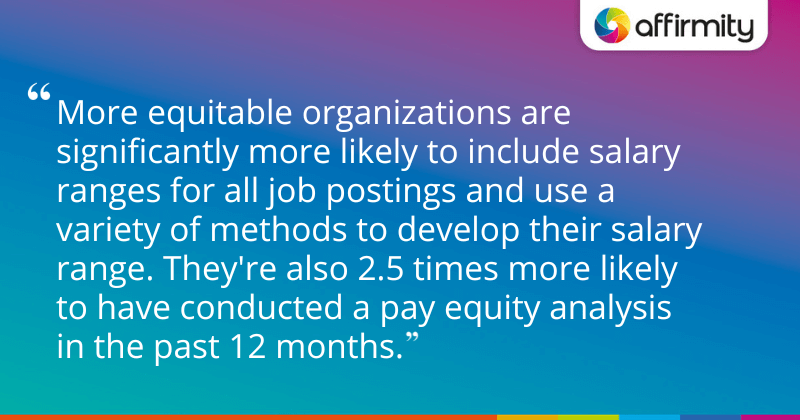Are organizations ready for increasing scrutiny on pay equity, pay transparency, and pay fairness from lawmakers and candidates alike? The Affirmity-sponsored white paper ‘The State of Pay Equity 2023-24’ provides something of a mixed picture. In this blog post, we’ve picked out four insights from the report that will help you understand whether you’re leading the way or falling short of the rising tide of expectation.
1) Pay Equity Is Stagnating In Many Organizations…
The overall impression given by the report is that while a core set of organizations are blazing a trail for others to follow, and the majority at least recognize they ought to be doing something about pay equity, there’s plenty of work to be done. When asked to rate their organization’s pay equity efforts on a scale of 1 to 10 (very poor to excellent), 47% rated their organization between 1 and 6, while a further 22% stretched to a 7. This means that the majority—just over two-thirds—rated their organization as mediocre or below.
Similarly, 75% describe their stage of development in pay equity terms as just “Intermediate” (37%), Beginning (20%), or Undeveloped (18%). The study defines an “Intermediate” level pay equity approach as having only “piecemeal” initiatives, with pay equity itself viewed as “moderately important” and little time spent on measuring success.
Accordingly, 23% of respondents say that pay equity isn’t viewed as an organizational priority. 34% state it’s a top five priority (27%) or the top priority (7%).
MORE BEST PRACTICE INSIGHTS FROM THE ARCHIVES | ‘5 Important Questions Answered in the 2023 Future of Diversity, Equity, Inclusion, and Belonging Report’

2) …However, There Is Hope for the Near Future
One optimistic note is that respondents at least believe that their organization will improve its pay equity situation in the next two years: 31% state it will become “much more equitable”, and 38% believe it will become “somewhat more equitable”. This forecast could be a combination of the anticipated effect of current efforts, as well as the possibility of new initiatives taking place in the near future.
When asked about the top five reasons why their organizations are focusing on pay equity, the two most popular answers among respondents were “retaining the right talent” (63%) and “ensuring fairness” (63%). Significantly, these answers were a step ahead of “ensuring compliance with laws and regulations” (47%), suggesting that even as laws shift to make pay equity non-optional, a good number of businesses are responding to candidate-led pressures.
This theme is perhaps reflected in the survey responses to pay transparency, specifically the question “does your organization include salary ranges in job postings”. Whereas 43% say they include salary ranges for all job postings and 17% say they do for some, just 16% state that they only do so as a result of legal obligations.

3) Organizations Are Split on Using Data to Improve Pay Equity
While half of the respondents agree (33%) or strongly agree (20%) that their organizations analyze and leverage data to improve pay equity, this still leaves a large number who aren’t convinced. 28% gave a neutral answer, suggesting doubt over whether data is being properly collected or applied to the problem. The remaining fifth disagreed with the statement—raising serious questions about how these organizations intend to address pay equity going forward.
Additionally, of those respondents who knew whether their organization performed pay equity analyses, 63% said that their organization had conducted one in the last 12 months. 37% said their organization hadn’t.
One positive in the report is that 8 out of 10 respondents believe their organization takes action to close pay gaps if inequities are found. However, the lack of data usage, and the fact that only 61% have strategies in place to detect equity gaps, suggests that these good intentions won’t always translate into action.
LEARN MORE ABOUT PAY EQUITY DATA | ‘6 Pay Equity Analysis Software Features That Simplify Your Process’

4) The Habits of More Equitable Organizations Provide a Blueprint for Best Practice
The report segments its insights with responses to the question “On a scale of 1 to 10, how would you rate your organization in the area of pay equity?”. Organizations with scores of 8 to 10 are characterized as “more equitable organizations”, and their tendencies are summarized throughout in order to provide a hint toward some best practice actions for any organization that also wishes to be more equitable.
More equitable organizations are:
- Significantly more likely to include salary ranges for all job postings (58% versus 35%)
- More likely to use a variety of methods to develop their salary ranges (using external market analysis 81% of the time, and government sources 46% of the time)
- 2.5 times more likely to have conducted a pay equity analysis in the past 12 months (77% versus 33%)
- 2.3 times more likely to have strategies in place to detect equity gaps (73% versus 32%)
- Twice as likely to make hiring offers based on factors other than salary history (85% versus 42%)
- 1.8 times more likely to close pay gaps if inequities are found (88% versus 49%)
KEEP READING OUR THOUGHTS ON PAY EQUITY | ‘A 5-Point Plan for Designing a Culture That Embraces Pay Equity’
Get the Full Pay Equity Picture for 2023-24
This is just a sample of the insights from this year’s State of Pay Equity report. The full 51-page report dives deeper into the data above while featuring a range of other important pay equity topics. Download the full white paper to discover:
- The roles on which organizations are focusing their pay equity efforts
- Who typically takes responsibility for pay equity in most organizations
- How key insights vary based on organization size and location
- The factors that organizations take into consideration when making pay decisions
- How organizations typically measure pay equity
- And more!
Ready to learn more about the pay equity landscape? Download your copy of the full white paper today. Then, to learn how we can help you get pay equity right, please get in touch.
 About the Author
About the Author
Patrick McNiel, PhD, is a principal business consultant for Affirmity. Dr. McNiel advises clients on issues related to workforce measurement and statistical analysis, diversity and inclusion, OFCCP and EEOC compliance, and pay equity. Dr. McNiel has over ten years of experience as a generalist in the field of Industrial and Organizational Psychology and has focused on employee selection and assessment for most of his career. He received his PhD in I-O Psychology from the Georgia Institute of Technology. Connect with him on LinkedIn
